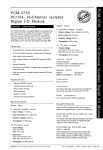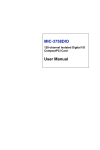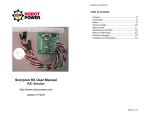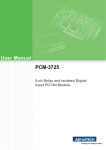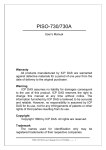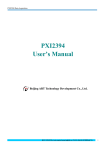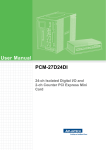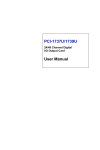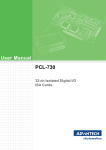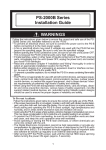Download PCM-3730 User Manual
Transcript
PCM-3730 32-ch Isolated Digital I/O Module User Manual Copyright The documentation and the software included with this product are copyrighted 2005 by Advantech Co., Ltd. All rights are reserved. Advantech Co., Ltd. reserves the right to make improvements in the products described in this manual at any time without notice. No part of this manual may be reproduced, copied, translated or transmitted in any form or by any means without the prior written permission of Advantech Co., Ltd. Information provided in this manual is intended to be accurate and reliable. However, Advantech Co., Ltd. assumes no responsibility for its use, nor for any infringements of the rights of third parties, which may result from its use. Acknowledgements PC-LabCard is a trademark of Advantech Co., Ltd. IBM and PC are trademarks of International Business Machines Corporation. MS-DOS, Microsoft C and Quick Basic are trademarks of Microsoft Corporation. BASIC is a trademark of Dartmouth College. Intel is a trademark of Intel Corporation. Turbo C is a trademark of Borland International. All other product names or trademarks are properties of their respective owners. Part No. 2003m37300 2nd Edition Printed in Taiwan May 2005 PCLD-782B Isolated D/I Board This board provides 24 optically-isolated digital input channels and a cable to connect to the PCM-3730's digital input ports. PCLD-885 The PCLD-885 provides 16 SPST power relay channels with a maximum contact rating of AC: 250 V, 5 A or DC: 20 V, 5 A. The PCLD-885 can be driven directly by the digital outputs of PC-LabCards through 20-pin flat-cable connectors or 50-pin OPTO-22 compatible connectors. PCLD-780 This wiring terminal board makes analog or digital I/O connections easy. PCLD-880 The PCLD-880 is a universal screw terminal board for industrial wiring. It can be used with the analog or digital ports of various PC-LabCards via 20-pin flat cables or shielded round cables with DB-37 connectors. Installation Initial inspection We carefully inspected the PCM-3730 both mechanically and electrically before shipment. It should be free of marks and in perfect order on receipt. As you unpack the PCM-3730, check it for signs of shipping damage (damaged box, scratches, dents, etc.). If it is damaged or fails to meet specifications, notify our service department or your local sales representative immediately. Also, call the carrier immediately and retain the shipping carton and packing material for inspection by the carrier. We will then make arrangements to repair or replace the unit. Discharge any static electricity on your body before you touch the board by touching the back of the system unit (grounded metal). Remove the PCM-3730 module from its protective packaging by grasping the rear metal panel. Handle the card only by its edges to avoid static electric discharge which could damage its integrated circuits. Keep the antistatic package. Whenever you remove the card from the PC, please store the card in this package for protection. You should also avoid contact with materials that hold static electricity such as plastic, vinyl and styrofoam. Switch and jumper settings The PCM-3730 module has one function switch and three jumper settings. The following sections tell how to configure the card. You may want to refer to the figure below for help in identifying module components. CN1 PCM-3730 REV.A1 CN3 JP3 JP4 SW1 JP2 CN2 Connectors, Jumpers, and Switches Label Function CN1 Digital output CN2 2 Digitalinput PCM-3730 User's Manual Interruptlevel JP3 Interrupt source JP4 Interrupt trigger SW1 Card base address Rising edge interrupt triggering (Default) l Isolated input/output JP2 l CN3 ¡ Falling edge interrupt triggering (SW1) Interrupt source (JP3) Jumper JP3 controls the card's IRQ level, as shown below: JP3 Interrupt source Card I/O addresses (SW1) Switch position Range (hex) 1 2 3 Setting IDI0 ¡ ¡ ¡ ¡ IDI0 IDI1 DI0 DI1 We set the PCM-3730 for a base address of Hex 300 at the factory. If you need to adjust it to some other address range, set switch SW1 as shown in the following table: ¡ ¡ You control the PCM-3730's operation by reading or writing data to the PC's I/O (input/output) port addresses. The PCM-3730 requires four consecutive address locations. Switch SW1 sets the card's base (beginning) address. Valid base addresses range from Hex 200 to Hex 3F0. Other devices in your system may, however, be using some of these addresses. l l Base address selection Channel Isolated DI channel 0 Connector CN3 pin11 4 5 6 7 8 IDI1 Isolated DI channel 1 CN3 pin12 200 - 203 ¡ l l l l l l l DI0 TTL DI channel 0 CN2 pin 1 204 - 207 ¡ l l l l l l ¡ DI1 TTL DI channel 1 CN2 pin 2 ¡ ¡ l l l l l l Hardware ¡ ¡ ¡ ¡ ¡ ¡ l l ´ *300 - 303 installation ´ 3F0 - 3F3 ¡ = Off l l= On * = default Note: Switches 1-6 control the PC bus address lines as shown below: Warning! TURN OFF your PC power supply whenever you install or remove the PCM-3730 or connect and disconnect cables. Installing the card in your computer Switch Line 1 A9 2 A8 3 A7 4 A6 5 A5 6 A4 7 A3 8 A2 1. Turn the computer off. Turn the power off to any peripheral devices such as printers and monitors. Page 6 provides a PC I/O port address map to help you avoid the I/O addresses for standard PC devices. 2. Disconnect the power cord and any other cables from the back of the computer. Interrupt level (JP2) 3. Remove the system unit cover (see the user's guide for your chassis if necessary). Jumper JP2 controls the card's IRQ level, as shown below. Position X disables the interrupt. 4. Remove the CPU card from the chassis (if necessary) to gain access to the card's PC/104 connector. JP2 Interrupt level l l ¡ ¡ ¡ ¡ ¡ ¡ ¡ ¡ ¡ ¡ ¡ ¡ 7 6 5 4 3 2 X (the default) Interrupt triggering (JP4) Jumper JP4 selects the trigger edge (rising or falling) on which the card will trigger an interrupt. Jumper settings appear below: JP4 Trigger method l PCM-3730 User's Manual l ¡ 5. Screw the bras spacer (included with the module) into the threaded hole on the CPU card. Do not tighten too much, or the threads may be damaged. 6. Carefully align the pins of the PCM-3730 with the PC/ 104 connector. Slide the module into the commector. The module pins may not slide all the way into the connector; do not push too hard or the module may be damaged. 7. Secure the module to the CPU card to the threaded hole in the CPU card using the included screw. 8. Attach any accessories to the PCM-3730 using 20 pin flat cables. 9. Reinstall the CPU card and replace the system unit cover. Reconnect the cables you removed in step 2. Turn the power on. This completes the hardware installation. Install the software driver as described in the following section. 3 Signal Connector CN3 — Isolated input and output connections Good signal connections can avoid a lot of unnecessary damage to your valuable PC and other hardware. This chapter gives pin assignments for each of the card's connectors and signal connections for different applications. Connector pin assignments The PCM-3730 has three on-board 20-pin flat-cable connectors (insulation displacement, mass termination) See the figure on page 2 for the location of each connector. IDO 0 IDO 2 IDO 4 IDO 6 EO.GND IDI0 IDI2 IDI4 IDI6 EI.COM1 1 3 5 7 9 11 13 15 17 19 2 4 6 8 10 12 14 16 18 20 IDO1 IDO3 IDO5 IDO7 EO.COM IDI1 IDI3 IDI5 IDI7 EI.COM2 Pin assignments for each connector appear in the following sections. TTL-level I/O Abbreviations DO Digital output DI Digitalinput The PCM-3730 has 16 TTL-level digital inputs and 16 TTLlevel digital outputs. The following figure shows connections to exchange digital signals with other TTL devices: D.GND Digital ground ID0 Isolated digital output IDI Isolated digital input PCM-3730 PCL-730 TTL Devices DO EO.GND External ground for isolated output EI.COM1 External common Vcc/GND for isolated input IDI0~IDI3 EI.COM2 External common Vcc/GND for isolated input IDI4~IDI7 EO.COM Free wheeling common diode for isolated output IDOØ~IDO7 Connector CN1 – Digital output DO 0 DO 2 DO 4 DO 6 DO 8 DO 10 DO 12 DO 14 D.GND +5 V 1 3 5 7 9 11 13 15 17 19 2 4 6 8 10 12 14 16 18 20 DO 1 DO 3 DO 5 DO 7 DO 9 DO 11 DO 13 DO 15 D.GND +12 V DI D.GND D.GND If you want to receive an OPEN/SHORT signal from a switch or relay, add a pull-up resistor to ensure that the input is held at a high level when the contacts are open. See the figure below: +5V 4.7K PCL-730 PCM-3730 DI Switch Connector CN2 — Digital input DI 0 DI 2 DI 4 DI 6 DI 8 DI 10 DI 12 DI 14 D.GND +5 V 4 1 3 5 7 9 11 13 15 17 19 2 4 6 8 10 12 14 16 18 20 DI 1 DI 3 DI 5 DI 7 DI 9 DI 11 DI 13 DI 15 D.GND +12 V D.GND PCM-3730 User's Manual Isolated Input Each of the 8 isolated digital input channels accept voltages from 5 to 24 V and have a resistance of 2.0 kW . Every four input channels share one external ground. (Channels 0~3 use EI.COM1. Channels 4~7 use EI.COM2.) The following figure shows how to connect an external input source to the card's isolated inputs: Vc External circuit Internal circuit 2K/0.5W IDI0 Switch PC354 Vc 2K/0.5W IDI1 5~24V PC354 Vc 2K/0.5W IDI3 EI.COM1 PC354 Isolated Output Each of the 8 isolated digital output channels comes equipped with a darlington transistor. Every eight output channels share common emitters and integral suppression diodes for inductive load, actived by connecting EO.COM to VDD. If the external voltage (5~40 V)is connected to each isolated output channel (IDO) and its isolated digital output turns on (200 mA per channel maximum), the card's current will sink from the external voltage. The current for all channels combined exceeds 150 mA, The following figure shows how to connect an external output load to the card's isolated outputs. External circuit Internal circuit DIODE EO.COM IDO0 DIODE IDO1 DIODE IDO2 Vcc DC-DC DIODE PC357 COMMO NC NO IDO7 Relay EO.GND PCM-3730 User's Manual 5V~40V 5 Register format PC I/O port address map Programming the PCM-3730 is extremely simple. Each I/O channel corresponds to a bit in the card's registers. To turn on an output channel you write a ‘‘1” to the corresponding bit. To read an input port, you simply read from the register. The card requires nine I/O register addresses, but you only need to access the first four registers, the data registers. The address of each register is specified as an offset from the card's base address. For example, BASE+0 is the card's base address and BASE+2 is the base address + two bytes. If the card's base address is 300h, the register's address is 302h. See "Switch and jumper settings" for information on setting the card's base address. Register Assignments PC I/O port address map Range (hex) 000 - 1FF Function Base system 200 Reserved 201 Game control 202 - 277 Reserved 278 - 27F LPT2: (2nd printer port) 280 - 2F7 Reserved 2F8 - 2FF COM2: 300 - 377 Reserved 378 - 37F LPT1: (1st printer port) Reserved Address BASE+0 Write IDO bits 0-7 Read IDI bits 0-7 380 - 3AF 3B0 - 3BF Mono Display/Print adapter BASE+1 NA NA 3C0 - 3CF Reserved BASE+2 DO bits 0-7 DI bits 0-7 3D0 - 3DF Color/Graphics BASE+3 DO bits 8-15 DI bits 8-15 3E0 - 3EF Reserved 3F0 - 3F7 Floppy disk drive 3F8 - 3FF COM1: 6 PCM-3730 User's Manual







